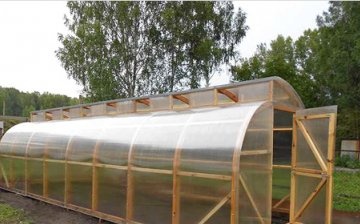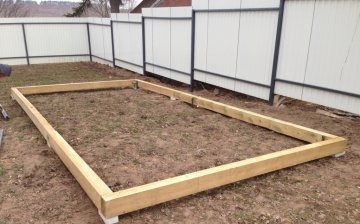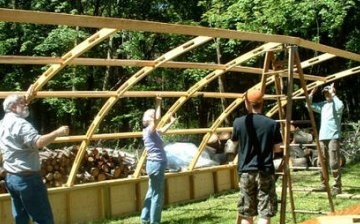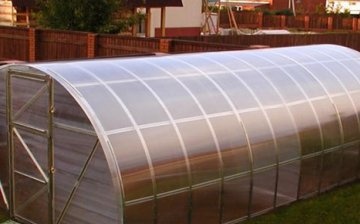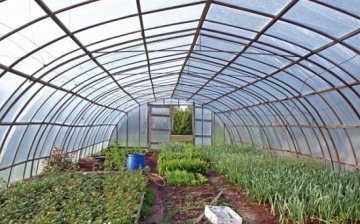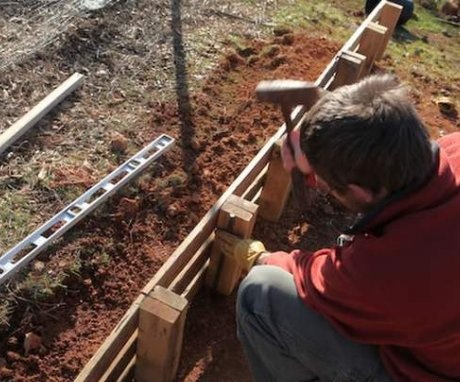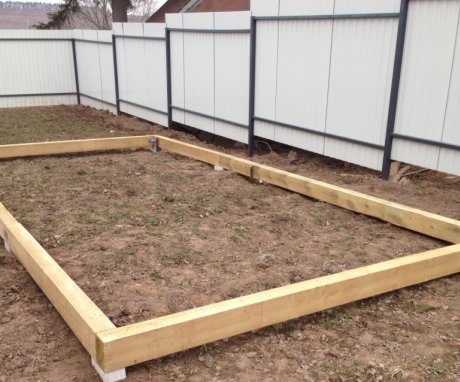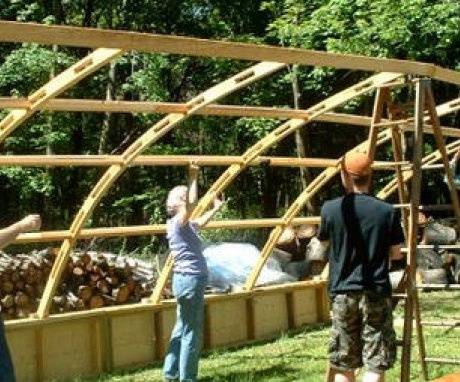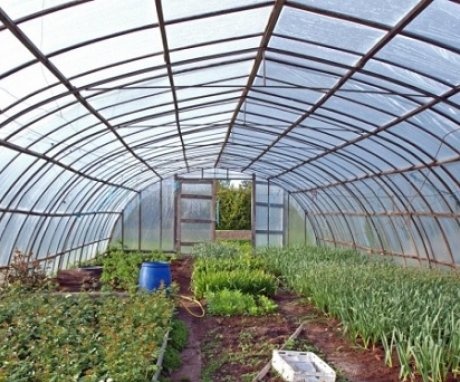Do-it-yourself greenhouse made of wood: the choice of material and the construction process
A material such as wood will never go out of fashion, so greenhouses made from it are in high demand today. Although it is generally accepted that metal is more durable, modern gardeners increasingly prefer environmentally friendly materials. With proper processing and the right choice of wood type, such a greenhouse will last for more than a decade.
Content:
- The choice of wood for the greenhouse
- Choosing a place, calculating the area and shape of the greenhouse
- Greenhouse construction process
- How to cover the greenhouse?
- Varieties of greenhouses made of wood
- Preparing the greenhouse for work
The choice of wood for the greenhouse
A do-it-yourself greenhouse made of wood is the most economical and creative way to grow a rich harvest. As you know, only the frame of the greenhouse is made of wood, and from above the structure is covered with a thin material that allows light to pass through, such as a transparent film, polycarbonate or glass.
What kind of wood is more suitable for a greenhouse:
- Pine. Pine timber is durable and resistant to various adverse influences. In addition, it is quite light and less prone to decay. With careful processing or painting, such a bar will last a long time. Pine timber is easy to find, it is a common material, although not the cheapest.
- Larch. Larch is highly resistant to moisture (it is less prone to rotting than pine). It is a very durable material that can withstand the damaging effects of water (thanks to the resins that have impregnated the wood). Larch has one more important property - over time it does not soften, but hardens, "turns to stone". Larch timber practically does not need special impregnation and processing, only the part that will be in contact with the ground can be processed. And of course, larch is a highly aesthetic material, although this is not the most important property for a greenhouse.
- Oak. Oak has long been one of the most durable and expensive materials. For the construction of greenhouses, it is not used so often, but if material capabilities allow, it is quite possible to make yourself such a solid and beautiful greenhouse. Oak is also resistant to decay.
- Spruce. Spruce timber has an affordable price and high quality characteristics. One of the disadvantages of spruce is that it is not resistant to decay. Therefore, spruce beams need to be processed and impregnated. The spruce contains an insufficient amount of resins that prevent putrefactive processes.
Choosing a place, calculating the area and shape of the greenhouse
If you decide to build a greenhouse, the first step is to think about where it will be located. The happy owners of a large garden area will not have any problems with choosing a place. However, if the area of the site is small, you will have to be creative to position the greenhouse correctly.
The ideal location for a greenhouse is a flat and well-lit plot of land.
For this reason, it is not worthwhile to put greenhouses under trees, as well as next to high fences and on the north side of the house, since these places are often covered with shade.Small shrubs do not block the light and do not interfere with the growth and fruiting of plants in the greenhouse. Of course, additional lighting can be added to the greenhouse, but this will be very expensive.
If you are planning a film greenhouse, then it must be protected from strong winds, as they can damage the thin film. For a small backyard, a wall-mounted greenhouse can be recommended. This is a small building, which is attached directly to the house from the south, sunny side.
The most common type of greenhouse is a wooden one with a gable roof. It should be located from north to south in length, and a lean-to - from west to east. The height of the greenhouse is determined not so much by the plants as by the height of the person. It is advisable that you can stand upright in your greenhouse to your full height. This will be the most convenient option.
The area of the greenhouse depends on many factors: on the volume of the desired crop, on the size of the plot and financial possibilities. The most common greenhouse sizes are 3 by 6 meters. Such a building does not take up much space and will allow you to grow enough crops to feed the whole family.
The shape of the structure is not that important. It only depends on the imagination of the builder. You can make a greenhouse in the form of an arch, a pyramid, or a house. The main thing is to ensure an adequate supply of light.
It must be remembered that not all plants get along together. Therefore, there is not always a need for a large greenhouse. Plants under the same roof should have the same need for lighting, temperature and humidity. For example, cucumbers and tomatoes usually do not get along well, as they tolerate high humidity in different ways.
Greenhouse construction process
In order to build a greenhouse from wood on your own, you will need diligence, a day off, a little knowledge, and at least one knowledgeable assistant. Building a standard greenhouse is usually straightforward.
Any construction begins with the purchase of building materials. If you are building for the first time and are not confident in your abilities, it is better to save on materials by choosing those that will last exactly one year.
Once you get your hands on it, you can make a more durable greenhouse at a higher cost. When all materials have been purchased, the wood must be treated with antiseptics to protect it from moisture and decay.
How to start building a greenhouse correctly:
- The land plot intended for a greenhouse must be carefully leveled, and then checked with a level. If you plan to bring water or heating to the greenhouse, you need to take care of laying the pipes before the foundation is installed.
- The next stage is laying the foundation and foundation. The greenhouse may not have a foundation, but in this case it will not last long. The foundation is able to extend the "life" of the building twice. It is best to choose a brick foundation. It is quite durable and inexpensive. The foundation should not go deep into the ground, a meter will be enough for a greenhouse, and about 30 cm should rise above the ground.
- The timber frame is easy to install. To do this, you need to fix thicker bars on the foundation, paint them or treat them with an antiseptic, and then the base is attached to the supporting bar.
- In the process of fixing the beams, do not forget to check the ratio of the walls. They must be firmly connected to each other.
- After the base is ready, it must be covered with light-transmitting material. It can be regular film, glass, polycarbonate, or even plastic bottles. It is better to seal the seams with a sealant so that cold air and wind do not penetrate into the greenhouse.
When the greenhouse is fully covered, sealed and at first glance is ready for use, you need to take care of additional lighting, conduct water and insulate the structure.
How to cover the greenhouse?
Among the transparent coatings, the weight of which a wooden frame can withstand, four varieties are most common:
- Film. This is the most economical option, it is perfect for beginners, since it is not a pity to spoil the film and you can always buy more. Such a coating will last only one year and will definitely not withstand the Russian winter. For the winter, a well-preserved film can be removed and removed, and pulled again next spring. Such a coating is applied very simply, the film must be stretched and fixed sequentially from one side to the other. It is necessary to take care of additional compaction in the places of the greatest film tension.
- Polycarbonate. It is the most popular material at the moment, it is used in construction, repair, manufacture of doors and furniture. Polycarbonate is inexpensive and lasts a long time. It is durable, easy and quick to attach, resistant to negative factors, transmits sunlight well, has thermal insulation properties, and weighs a little. This material is available in panels for easy installation.
- Glass. Glass greenhouses in our time are not often seen due to their fragility and some complexity of installation. Glass, even the toughest glass, is more prone to cracks and chips than polycarbonate, and it is also heavier in weight, which complicates the installation process. However, the installed glass is stronger than other materials. You need to buy glass after installing the wooden frame in order to know exactly the amount of required material and not waste money again.
- Plastic bottles. This is an option for the most creative gardeners who want to surprise their neighbors with a unique greenhouse and have a couple of thousand bottles in stock. You can simply string bottles without a bottom on top of each other so that you get a cocoon, but such a greenhouse does not keep heat well. There is also another option. The middle of the plastic bottle is cut across. The resulting rectangle is straightened, the edges are aligned and sewn with others of the same. Such a coating will retain heat well, and is not inferior in strength to polycarbonate.
Varieties of greenhouses made of wood
First of all, you need to distinguish between the concepts of "greenhouse" and "greenhouse". A greenhouse is a much simpler design, the main task of which is to protect seedlings from wind and cold. In fact, a greenhouse is simply covering the beds with a film stretched over rods or beams.
A greenhouse is a larger and more complex structure than a greenhouse.
All greenhouses can be divided into two large groups:
- Seasonal greenhouses. These are structures that do not have a foundation and a permanent location. They are put only for the summer, and then easily folded and removed for the winter in a barn or cellar. Such greenhouses are used quite often, since usually a greenhouse structure is needed only in the warm season. You can make a seasonal greenhouse with your own hands or buy a ready-made one in gardening stores.
- Capital greenhouses. The capital greenhouse has a permanent location. It is more durable, weather-resistant and durable than seasonal, and has a foundation. These greenhouses are supplied with light, water and heat to support plant growth year-round.
Capital wooden greenhouses also have their own varieties. So, a capital greenhouse can also be collapsible or permanent.
Moreover, not only the coating, but also the wooden frame itself can be disassembled. Each type has its own pros and cons. The collapsible one has to be assembled and disassembled every time, which takes some time, and the permanent ones will be a target for thieves, since thefts in summer cottages are not uncommon.
It has already been said above that wooden greenhouses differ in the material used for covering: polycarbonate, glass, polyethylene, etc.
Greenhouses are also classified according to their shape:
- A standard rectangular greenhouse with a gable roof.
- Single-slope wall-mounted greenhouse.
- Greenhouse according to Mittlider (has 2 slopes of different heights and windows for ventilation at the top).
- Arched greenhouse. A rounded greenhouse is easier to cover with foil due to the lack of corners. It also helps save material. However, instead of a wooden frame, plastic or metal rods are most often used, or the frame is partially wooden.
- Pyramid. This is a rather complex design, the benefits of which have not yet been proven. However, if you have the time and desire to make such an interesting greenhouse, you can certainly find many advantages of this structure.
Preparing the greenhouse for work
When the greenhouse is fully assembled and covered, the first step is to take care of sealing the joints. You can purchase a sealant from a store, choosing the one that works best for your greenhouse material.
Then you need to think over the heating system:
- Heating will be needed both for a year-round greenhouse and for a seasonal one, since in March it is still quite cold here. You can place radiators in the greenhouse, or choose a place where pipes with hot water are laid. This option will be the most economical, but, unfortunately, not always possible.
- Some worry that the pipes will rot from constant watering, but there is no reason for concern, the pipes are well protected from moisture, and moreover, water from irrigation often simply does not reach them.
- It is possible to maintain the temperature in the greenhouse with air cannons. However, such heating devices burn oxygen and dry the air, which can adversely affect the crops grown. Nowadays there are a lot of devices for safer heating, for example, infrared heaters.
The ventilation system is equally important. The easiest way to ensure the flow of air is through the vents and windows in the greenhouse. However, they need to be positioned correctly. Small vents should be located on the walls and under the roof of the greenhouse to ensure sufficient air circulation.
There are automatic electric fans that cool the air in the greenhouse to the desired temperature. The disadvantages of such devices include the high cost and electricity bills.
More powerful hydraulic fans are more suitable for capital large year-round greenhouses.
Watering can be organized using hoses familiar to everyone or more modern irrigation systems, as well as drip irrigation devices, which will completely allow you to forget about having to stand with a hose every day and monitor the amount of water. Drip irrigation also saves water as you only water the plant itself, not the soil between the beds.
More information can be found in the video.



